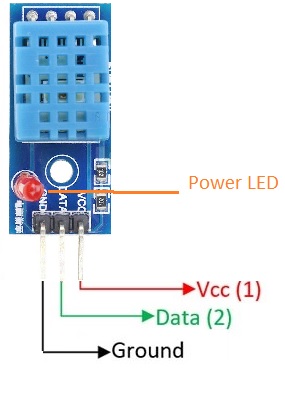Features:
- Accurate Relative Humidity and Temperature Measurement
- Full Range Temperature Compensation
- Calibrated Digital Signal Output
- DIP Red Power LED Indicator
- Long-Term Stability
- Low Power Consumption
- Ready-to-Use with Microcontrollers (MCUs)
- Screw Hole for Secure Fixation
Principle of Work:
The MCU initiates communication by sending a trigger signal. The DHT11 responds by sending 40 bits of pre-collected data via a single-wire digital interface. Each communication cycle transmits one data set, requiring a new trigger for the next reading.
Modules include a pull-up resistor and filter capacitor, unlike standalone sensors that may require these externally.
Pinout of the Board:

| Pin |
Label |
Description |
| 1 |
VCC |
Power supply (3.5V to 5.5V) |
| 2 |
Data |
Digital output (temperature and humidity) |
| 3 |
GND |
Ground |
Note: Incorrect wiring (reversing VCC and GND) may damage the sensor.
Applications:
- Home Automation
- Weather Monitoring Systems
- HVAC Control Systems
- Greenhouse and Precision Agriculture
- Temperature & Humidity Data Logging
- Industrial Process Monitoring
- IoT Environmental Sensing
- Laboratory Research and Experiments
Circuit Diagram:

Wiring with Arduino:
Connect:
- VCC → 5V on Arduino
- GND → GND on Arduino
- OUT → A0 (analog input pin on Arduino)
Library Installation:
- Download the DHT library (search for "DHT sensor library by Adafruit" in Library Manager).
- In Arduino IDE, go to
Sketch > Include Library > Manage Libraries....
- Install the library using the ZIP file or directly from the Library Manager.
Example Arduino Code:
#include "dht.h"
#define dht_pin A0 // Connect DHT11 OUT pin to analog pin A0
dht DHT;
void setup() {
Serial.begin(9600);
delay(500);
Serial.println("DHT11 Humidity & Temperature Sensor\n");
delay(1000);
}
void loop() {
DHT.read11(dht_pin);
float humidity = DHT.humidity;
float temperature = DHT.temperature;
Serial.print("Humidity = ");
Serial.print(humidity);
Serial.print("% ");
Serial.print("Temperature = ");
Serial.print(temperature);
Serial.println(" C");
delay(5000);
}
Technical Details:
- Input Voltage: 3.3V ~ 5.5V
- Current Consumption: 0.5mA ~ 2.5mA
- Output Type: Digital (one-wire interface)
- Humidity Range: 20% ~ 90% RH
- Humidity Accuracy: ±5% RH
- Humidity Resolution: 1% RH
- Temperature Range: 0°C ~ 50°C
- Temperature Accuracy: ±2°C
- Temperature Resolution: 1°C
- Power Indicator: Red LED
- Pin Count: 3
- Module Size: 32mm x 14mm
Comparisons:
| Feature |
DHT11 |
DHT22 |
LM35 |
| Temperature Range |
0°C to 50°C (±2°C) |
-40°C to 80°C (±0.5°C) |
-55°C to 150°C (±0.5°C) |
| Humidity Range |
20% to 90% (±5%) |
0% to 100% (±2-5%) |
— |
| Output Type |
Digital |
Digital |
Analog |
| Power Consumption |
Low |
Low |
Low |
| Stability |
Good |
Excellent |
Excellent |
| Cost |
Low |
Moderate |
Moderate |
| Application Areas |
Basic sensing, DIY |
Advanced environmental monitoring |
Industrial, precise temp monitoring |
Resources:
Features:
- Accurate Relative Humidity and Temperature Measurement
- Full Range Temperature Compensation
- Calibrated Digital Signal Output
- DIP Red Power LED Indicator
- Long-Term Stability
- Low Power Consumption
- Ready-to-Use with Microcontrollers (MCUs)
- Screw Hole for Secure Fixation
Principle of Work:
The MCU initiates communication by sending a trigger signal. The DHT11 responds by sending 40 bits of pre-collected data via a single-wire digital interface. Each communication cycle transmits one data set, requiring a new trigger for the next reading.
Modules include a pull-up resistor and filter capacitor, unlike standalone sensors that may require these externally.
Pinout of the Board:

| Pin |
Label |
Description |
| 1 |
VCC |
Power supply (3.5V to 5.5V) |
| 2 |
Data |
Digital output (temperature and humidity) |
| 3 |
GND |
Ground |
Note: Incorrect wiring (reversing VCC and GND) may damage the sensor.
Applications:
- Home Automation
- Weather Monitoring Systems
- HVAC Control Systems
- Greenhouse and Precision Agriculture
- Temperature & Humidity Data Logging
- Industrial Process Monitoring
- IoT Environmental Sensing
- Laboratory Research and Experiments
Circuit Diagram:

Wiring with Arduino:
Connect:
- VCC → 5V on Arduino
- GND → GND on Arduino
- OUT → A0 (analog input pin on Arduino)
Library Installation:
- Download the DHT library (search for "DHT sensor library by Adafruit" in Library Manager).
- In Arduino IDE, go to
Sketch > Include Library > Manage Libraries....
- Install the library using the ZIP file or directly from the Library Manager.
Example Arduino Code:
#include "dht.h"
#define dht_pin A0 // Connect DHT11 OUT pin to analog pin A0
dht DHT;
void setup() {
Serial.begin(9600);
delay(500);
Serial.println("DHT11 Humidity & Temperature Sensor\n");
delay(1000);
}
void loop() {
DHT.read11(dht_pin);
float humidity = DHT.humidity;
float temperature = DHT.temperature;
Serial.print("Humidity = ");
Serial.print(humidity);
Serial.print("% ");
Serial.print("Temperature = ");
Serial.print(temperature);
Serial.println(" C");
delay(5000);
}
Technical Details:
- Input Voltage: 3.3V ~ 5.5V
- Current Consumption: 0.5mA ~ 2.5mA
- Output Type: Digital (one-wire interface)
- Humidity Range: 20% ~ 90% RH
- Humidity Accuracy: ±5% RH
- Humidity Resolution: 1% RH
- Temperature Range: 0°C ~ 50°C
- Temperature Accuracy: ±2°C
- Temperature Resolution: 1°C
- Power Indicator: Red LED
- Pin Count: 3
- Module Size: 32mm x 14mm
Comparisons:
| Feature |
DHT11 |
DHT22 |
LM35 |
| Temperature Range |
0°C to 50°C (±2°C) |
-40°C to 80°C (±0.5°C) |
-55°C to 150°C (±0.5°C) |
| Humidity Range |
20% to 90% (±5%) |
0% to 100% (±2-5%) |
— |
| Output Type |
Digital |
Digital |
Analog |
| Power Consumption |
Low |
Low |
Low |
| Stability |
Good |
Excellent |
Excellent |
| Cost |
Low |
Moderate |
Moderate |
| Application Areas |
Basic sensing, DIY |
Advanced environmental monitoring |
Industrial, precise temp monitoring |
Resources:


